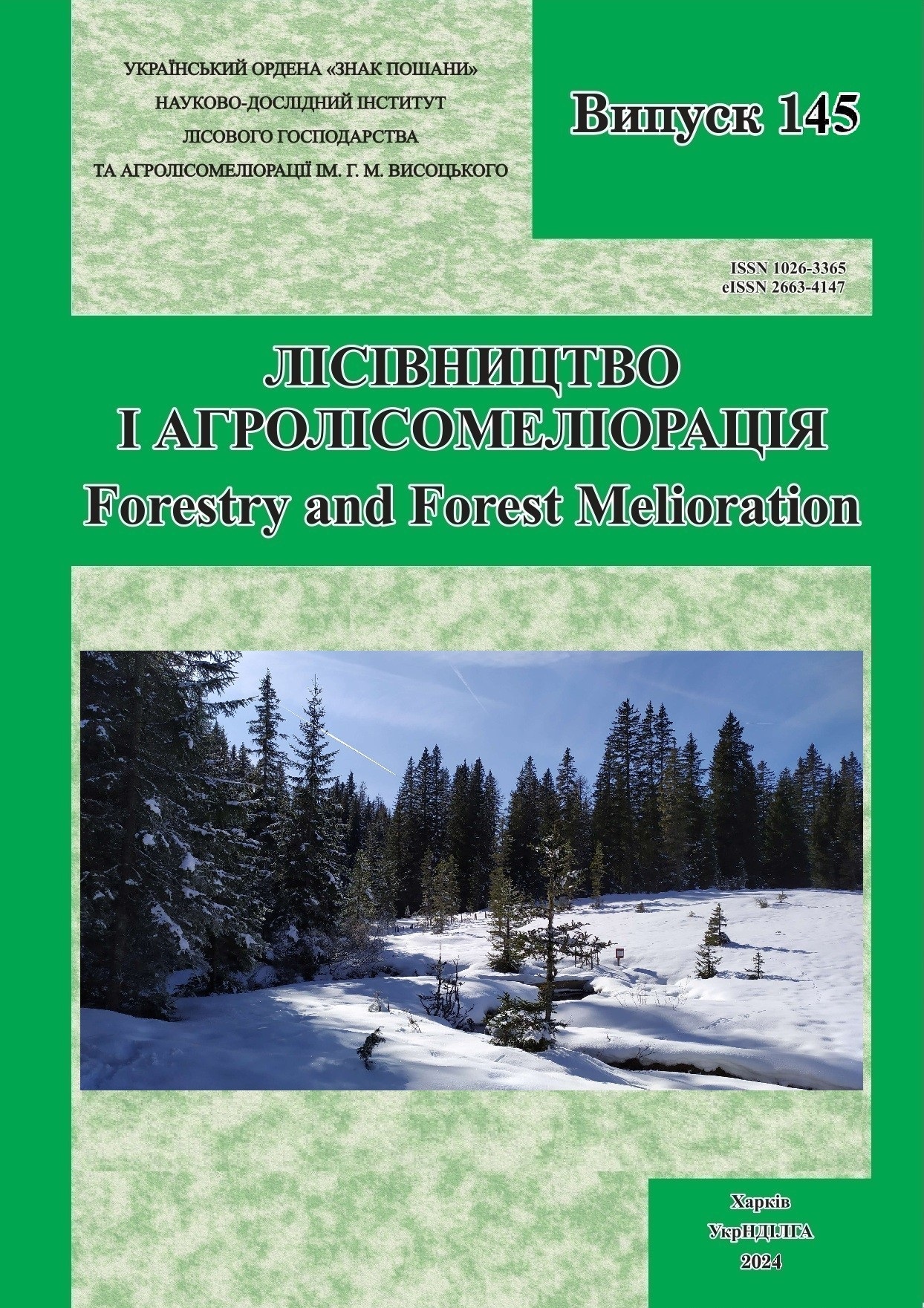Анотація
На листі Tilia cordata (Mill) визначено «погризи», «міни», «уколи», «гали», спричинені членистоногими, а також «плями» грибних уражень і «опіки» від дії забруднювачів повітря. Членистоногі презентовані двома видами класу Arachnida і 10 видами класу Insecta. Визначені види належать до 9 родів 7 родин 4 рядів, причому 5 видів є монофагами. Пошкоджені листки становили в середньому 21,5±1,84 % з переважанням «погризів» (9,8±1,33 %) і «галів» (5,8±1,05 %). Поширеність та інтенсивність прояву «погризів» зменшувалися в ряді Ліс – Лісопарк – Парки – Двори та Вулиці. Поширеність галів була найбільшою в парках. Міни виявлено лише у насадженнях перших трьох типів. Поширеність уколів була найбільшою у дворових і вуличних насадженнях, плямистостей листя – у лісових насадженнях, Лісопарку і парках. Опіки листя виявлено лише у вуличних насадженнях. Найбільше вилучення листя в лісових насадженнях спричиняли комахи, що спричиняють погризи (8,9 %), та мінери (3,45 %). Найбільше вилучення листя комахами, що спричиняють уколи, відмічено у дворах і парках (0,45 і 0,41 % відповідно), галоутворювачами – у парках (3,1 %), внаслідок розвитку плямистостей – у парках (0,47 %), опіків листя – у вуличних насадженнях (0,6 %).
Посилання
Andrianjara, I., Cabassa, C., Lata, J.C., Hansart, A., Raynaud, X., Renard, M., ... and Planchais, S. (2024) ‘Characterization of stress indicators in Tilia cordata Mill. as early and long-term stress markers for water availability and trace element contamination in urban environments’, Ecological Indicators, 158, 111296. https://doi.org/10.1016/j.ecolind.2023.111296
Atramentova, L. O. and Utievska, O. M. (2007) Group comparison and relations analysis: Biometrics. Part II. Kharkiv: Ranok (in Ukrainian).
Blake, E., Bennett, S. and Hruska, A. (2024) ‘Insect herbivory on Acer rubrum varies across income and urbanization gradients in the D.C. metropolitan area’, Urban Ecosystems, 27, pp. 2191–2200. https://doi.org/10.1007/s11252-024-01584-4
Branco, M., Nunes, P., Roques, A., Fernandes, M.R., Orazio, C. and Jactel, H. (2019) ‘Urban trees facilitate the establishment of non-native forest insects’, NeoBiota, 52, pp. 25–46. https://doi.org/10.3897/neobiota.52.36358
Ellis, W.N. (2024) Plant parasites of Europe: leafminers, galls and fungi. Available at: https://bladmineerders.nl (Accessed: 20 September 2024).
Index Fungorum (2024). Available at: https://www.indexfungorum.org (Accessed: 20 September 2024).
Kabicek, J. (2019) ‘Linden trees are favourable host plants for Phytoseiid generalists in urban environments’, Baltic Forestry, 25(1), pp. 32–37.
Kardash, Ye.S. (2021a) ‘Changes in the complex of phyllophagous insects in deciduous trees of Kharkiv city for 50 years’, Baltic Coastal Zone, 24, pp. 27–39. Available at: https://bcz.upsl.edu.pl/index.php/1/article/view/372 (Accessed: 20 September 2024).
Kardash, Ye.S. (2021b). ‘Features of trophic activity of phyllophages in green stands of Kharkiv’, The Kharkiv Entomological Society Gazette, 29(1), pp. 77–84 (in Ukrainian). https://doi.org/10.36016/KhESG-2021-29-1-7
Kardash, Ye.S. and Sokolova, I.M. (2020) ‘The structure of phyllophagous insects’ complexes in deciduous plantations in Kharkiv’, Biodiversity, Ecology and Experimental Biology, 1, pp. 70–81 (in Ukrainian). https://doi.org/10.34142/2708-5848.2020.22.1.07
Karpyn, N.I. (2016) ‘Phytopathogens and pests of species of the genus Tilia L. in the city of Lviv’, Scientific Bulletin of UNFU, 26(4), pp. 76–82 (in Ukrainian). https://doi.org/10.15421/40260412
Karsholt, O. and Nieukerken, E.J. van. (2024) Lepidoptera, Moths. Fauna Europaea version 2017.06. Available at: https://fauna-eu.org (Accessed: 20 February 2024).
Khavaninzadeh, A.R., Veroustraete, F., Buytaert, J.A.N. and Samson, R. (2014) ‘Leaf injury symptoms of Tilia sp. as an indicator of urban habitat quality’, Ecological indicators, 41, pp. 58–64. https://doi.org/10.1016/j.ecolind.2014.01.014 4
Koll?r, J. (2011) ‘Gall-inducing arthropods associated with ornamental woody plants in a city park of Nitra (SW Slovakia)’, Acta Entomologica Serbica, 16(1/2), ph. 115–126.
Kolienkina, M.S. (2020) ‘Condition of small-leaved lime (Tilia cordata Mill.) in urban stands of Kharkiv (according to the spring survey)’, Scientific Bulletin of UNFU, 30(5), pp. 25–30 (in Ukrainian).
Kukina, O., Kardash, E. and Shvydenko, I. (2021). ‘Expected harmfulness of gnawing phyllophagous insects in urban stands of Kharkiv city’, Folia Forestalia Polonica, 63(4), pp. 267–275. https://doi.org/10.2478/ffp-2021-0027
Kukina, O., Shvydenko, I. and Kharchenko, L.P. (2024) ‘Biotic factors affecting Acer L. foliage damage in urban ecosystems of Kharkiv’, Biodiversity, Ecology and Experimental Biology, 26, 1 (in Ukrainian). https://doi.org/10.34142/2708-5848.2024.26.1.03
Langellotto, G. A. and Hall, D. (2020) ‘Urban insects’ in Routledge Handbook of Urban Ecology. Routledge, pp. 412–424.
Macko?-Iwaszko, E. and Lubiarz, M. (2014) ‘Abundance dynamics of the Lime Aphid Eucallipterus tiliae (L., 1758) on the Small-Laved Lime (Tilia cordata Mill.) in the city of Lublin (South-Eastern Poland)’ in Indykiewicz, P. and B?hner, J. (eds) Urban Fauna. Animal, Man, and the City – Interactions and Relationships. Bydgoszcz: Uniwersytet Technologiczno-Przyrodniczy w Bydgoszczy; ArtStudio, pp. 77–85.
Meshkova, V.L., Baidyk, G.V., Berezhnenko, Zh.I. (2018) ‘Dynamics of oak leaf damage by insects in forest belts of Kharkiv region’, Bulletin of Kharkiv National Agrarian University. Series "Phytopathology and Entomology", 1?2, pp. 92–100. Available at: https://knau.kharkov.ua/vfn201815.html (Accessed: 20 September 2024) (in Ukrainian).
Mikulina, I.M. (2011) ‘Seasonal development of lime leaf miner, Phyllonorycter issikii Kumata, 1963 (Lepidoptera: Gracillariidae) in the green stands of Kharkiv region’, The Kharkiv Entomological Society Gazette, 19(1), pp. 57–61 (in Ukrainian).
Oleksiychenko, N.O., Sovakova, M.O., Sovakov, O.V., Kitaev, O.I. and Slyusar, S.I. (2013) Species of the genus Tilia L. in the plantations of Kyiv. Kyiv: TSP KOMPRYNT (in Ukrainian).
Radoglou, K., Dobrowolska, D., Spyroglou, G. and Nicolescu, V.N. (2008) ‘A review on the ecology and silviculture of limes (Tilia cordata Mill., Tilia platyphyllos Scop. and Tilia tomentosa Moench.) in Europe’ Romania, 15, 16. Available at: http://www.valbro.uni-freiburg.de (Accessed: 20 September 2024).
Rahman, M.A., Moser, A., R?tzer, T. and Pauleit, S. (2017) ‘Within canopy temperature differences and cooling ability of Tilia cordata trees grown in urban conditions’, Building and Environment, 114, pp. 118–128. https://doi.org/10.1016/j.buildenv.2016.12.013
Sokolova, I.M., Shvydenko, I.M. and Kardash, E.S. (2020) ‘The prevalence of gnawing phyllophagous insects in the deciduous stands of Kharkiv city’, Ukrainian Entomological Journal, 1–2(18), pp. 67–79 (in Ukrainian). https://doi.org/10.15421/282009
Vainio, E.J., Velmala, S.M., Salo, P., Huhtinen, S. and M?ller, M.M. (2017) ‘Defoliation of Tilia cordata trees associated with Apiognomonia errabunda infection in Finland’, Silva Fennica, 51(4), 7749. https://doi.org/10.14214/sf.7749
Zaitseva, I.A. (2018) ‘Dendrobiont phyllophages of Tilia L. in Dnipro plantations: spring phenological group’, Issues of Bioindication and Ecology, 23 (1), pp. 146–168 (in Ukrainian). https://doi.org/10.26661/2312-2056/2018-23/1-12

Ця робота ліцензується відповідно до Creative Commons Attribution 4.0 International License.

